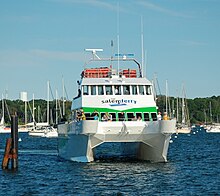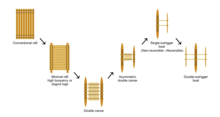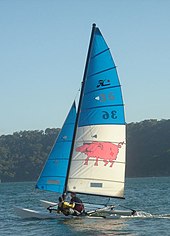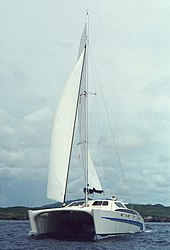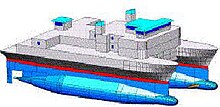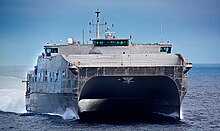Catamaran
The wide distance between a catamaran's hulls imparts stability through resistance to rolling and overturning; no ballast is required.
Catamarans typically have less hull volume, smaller displacement, and shallower draft (draught) than monohulls of comparable length.
The two hulls combined also often have a smaller hydrodynamic resistance than comparable monohulls, requiring less propulsive power from either sails or motors.
[1] Catamarans range in size from small sailing or rowing vessels to large naval ships and roll-on/roll-off car ferries.
The structure connecting a catamaran's two hulls ranges from a simple frame strung with webbing to support the crew to a bridging superstructure incorporating extensive cabin or cargo space.
[5][6][1] This would also explain why older Austronesian populations in Island Southeast Asia tend to favor double outrigger canoes, as it keeps the boats stable when tacking.
[5][6][1][7][8] Despite their being the more "primitive form" of outrigger canoes, they were nonetheless effective, allowing seafaring Polynesians to voyage to distant Pacific islands.
Crisp described it as "a fast sailing fine sea boat; she traded during the monsoon between Rangoon and the Tenasserim Provinces for several years".
It was as a result of this event, the Centennial Regatta of the New York Yacht Club, that catamarans were barred from regular sailing classes, and this remained the case until the 1970s.
The innovative design included two 30 HP Hispano-Suiza marine engines and could modify its configuration when sailing, positioning two rudders at the stern of each float, with the propellers also placed aft.
[24][25] In the mid-twentieth century, beachcats became a widespread category of sailing catamarans, owing to their ease of launching and mass production.
When boat speed increases and waves are generated the resistance is dependent on several design factors, particularly hull displacement to length and hull separation to length ratio, it is a non trivial resistance curve with many small peaks as wave trains at various speeds combine and cancel[32][33] For powered catamarans, this implies smaller power plants (although two are typically required).
[38] One measure of the trade-off between speed and carrying capacity is the displacement Froude number (FnV),[39] compared with calm water transportation efficiency.
[41] It uses a reference length, the cubic root of the volumetric displacement of the hull, V, where u is the relative flow velocity between the sea and ship, and g is acceleration due to gravity: Calm water transportation efficiency of a vessel is proportional to the full-load displacement and the maximum calm-water speed, divided by the corresponding power required.
[40] Two advances over the traditional catamaran are the small-waterplane-area twin hull (SWATH) and the wave-piercing configuration—the latter having become a widely favored design.
The spanning bridge deck may be configured with some of the characteristics of a normal V-hull, which allows it to penetrate the crests of waves.
Performance versions often have trapezes to allow the crew to hike out and counterbalance capsize forces during strong winds on certain points of sail.
"The Race" helped precipitate this trend; it was a circumnavigation challenge which departed from Barcelona, Spain, on New Year's Eve, 2000.
Because of the prize money and prestige associated with this event, four new catamarans (and two highly modified ones) over 100 feet (30 m) in length were built to compete.
[56] A cata-raft design has been used on the Colorado River to handle heavy whitewater, yet maintain a good speed through the water.
[59] The Swiss-registered wave-piercing catamaran, Tûranor PlanetSolar, which was launched in March 2010, is the world's largest solar powered boat.
Incat built HSC Francisco, a High-Speed trimaran that, at 58 knots, is (as of 2014) the fastest passenger ship in service.
[65] The first warship to be propelled by a steam engine, named Demologos or Fulton and built in the United States during the War of 1812, was a catamaran with a paddle wheel between her hulls.
In the early 20th Century several catamarans were built as submarine salvage ships: SMS Vulkan and SMS Cyclop of Germany, Kommuna of Russia, and Kanguro of Spain, all designed to lift stricken submarines by means of huge cranes above a moon pool between the hulls.
The use of catamarans as high-speed naval transport was pioneered by HMAS Jervis Bay, which was in service with the Royal Australian Navy between 1999 and 2001.
[67] First launched in 2004 at Shanghai, the Houbei class missile boat of the People's Liberation Army Navy (PLAN) has a catamaran design to accommodate the vessel's stealth features.


